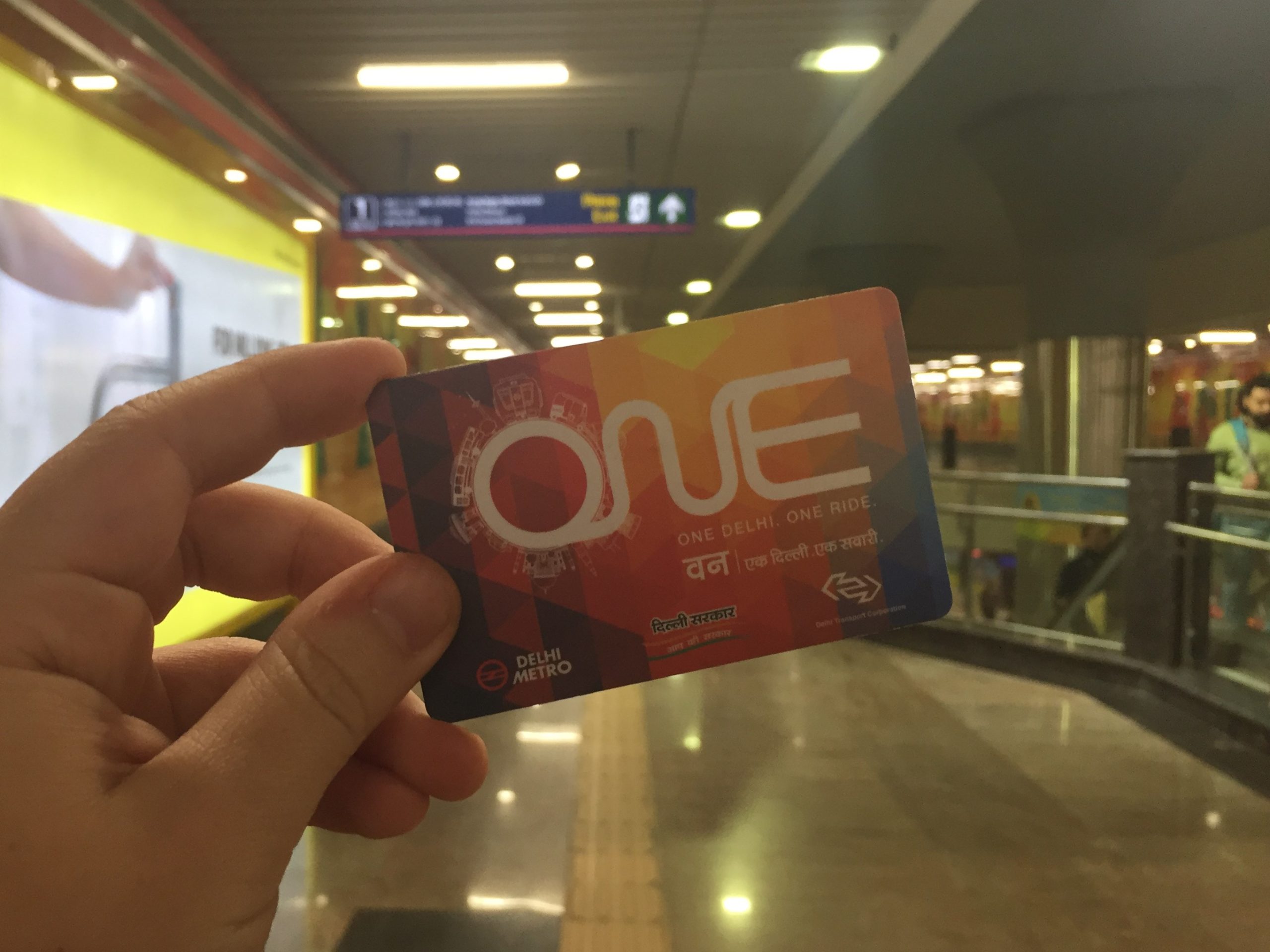The ease and relative low cost of public transit in Delhi was one of my top five favourite things about living there. This is partially was because I’m an American used to expensive and broken public transit, but I’ve also lived in Europe, and Delhi public transit is better than that too (I’ve never been anywhere else in Asia). I will go over mainly the metro and autorickshaws here, with smaller sections for Uber and buses.
The Delhi metro

Ah, the Delhi metro. Clean, climate-controlled, and crowded, it’s by far the best way to get around Delhi. In this blog series, I locate everything in relation to the nearest metro stop. It was my primary means of transport in exploring Delhi. It functions a bit differently than metros in other cities I’ve been to – notably the security measures, so here’s a quick guide.
Overall, the Delhi metro is better-operated than any other metro I’ve traveled on. If the train says it’s coming at a certain time, it will come at that time (plus, trains come very often anyways). Over hundreds of trips, I never once experienced a delay. The announcers announce each stop clearly in Hindi and English and videos on the train show which connections are coming up, making it very user-friendly. It’s a new metro (the oldest red, blue, and yellow lines are only 25 years old) so I hope this continues as it ages. Also, it’s cleaner than any metro I’ve traveled on. There are strong fines and social norms against eating, drinking, spitting, or smoking on the metro – avoid doing these things. Finally, many of the busier metro stations are lovely, including art, or photos of tourist attractions. I often had to transit through Dilli Haat (intersection of pink and orange lines) which had massive abstract art tiles that people often used as Instagram backgrounds.
Delhi metro operates on either a token or card system. I’d recommend just getting a prepaid card even if you’re going to be there only a few days – it’ll save you a ton of time and fees are negligible. Plus, like many metro cards it saves you like 20% every time you ride. It’s also aesthetically pleasing. You can buy them and refill them at the manned kiosk in any station (attendants will speak/understand English). If you really want to go the token route, you can find them at the self-service stations, like any other metro you enter your starting and ending station and they give you a token.
You’ll have to either swipe your card or enter your token on both ends of the metro, since it charges based on distance traveled, from 8 rupees for one stop. I’ve never been charged more than 40 rupees even for long journeys. I don’t know what happens if you lose your card on the metro but I’m sure someone would help you out.
The biggest difference between Delhi and every other metro I have been on is that you basically have to go through airport security to get in (malls in India are also like this). You line up in a line based on gender, and have to put your bag through a scanner before going through security. I would recommend watching how this works a couple times, since people will give you stink eye if you make the system slower, especially during rush hour.
Another excellent feature of the metro is the women’s car (unfortunate that it’s needed, but very fortunate they have it). It’s almost always less crowded than the mixed-gender cars (again, unfortunate that this is due to Delhi’s commuter population being overwhelmingly male) and thus a more comfortable place to travel – easier to get a seat, and you won’t be stared at. An aside: the first thing most female travelers (unless they are from elsewhere in North India or the Middle East) will notice in Delhi is the lack of women in public spaces. It’s unpleasant, and the metro women’s car is a nice respite from it for both local and foreign women.
Finally, there are bathrooms inside most metro stations that are manned by attendants and cost money to enter. Obviously they are not ideal, but given the cleaning fees, they are usually okay. Plus since there are handheld bidets you don’t have to worry about toilet paper or lack thereof. Just be prepared with 1-10 rupees for a fee (and yes, if you are a foreigner, maybe Indians will be charged 1 rupee and you will be charged 10, but do you really want to be the sort of tourist who fights a person who cleans bathrooms over 25 cents? I think not.)
Autorickshaws
If you still have a couple kilometres to travel once you get off your metro stop, the best way to get around is autorickshaw (or auto for short). These are the yellow-and-green open-air taxis (in some farther regions of the Delhi capital region, they are other colours and are shaped differently). They are amazing!
Usually drivers will have them on loan from different companies, but the drivers have the opportunity to decorate them. Mostly this will be with religious symbols or pictures of celebrities, but sometimes you get truly innovative ones, like drivers who have made all their seats bright pink, or put a strobe light. At any rate, there is no better way to get around town during the good weather than an autorickshaw.
In other Indian cities, notably Mumbai, autorickshaws have meters and fares are fixed. Good luck finding this in Delhi – you’ll have to bargain. The general tip I got from a coworker is 40 rupees total for the first two km, and 10 rupees (I heard 8 but round up) for each additional km after that. You can aim for this but again, if you are reading this blog you are probably rich, and the auto driver can use the extra 20 rupees more than you. Some tips I have for bargaining are to walk into more residential areas to catch autos – usually these auto drivers have lower original asking prices than drivers who at tourist hotspots. Also, auto drivers in Central Delhi will always try to charge like 10x the going rate – I mostly walked everywhere there.
If you want to avoid bargaining, you can also book autos on Uber. However, part of what makes autos great is their ubiquity and convenience, so it’s usually better to just catch whoever is there and try to bargain. You’ll need to know some Hindi to do this (I also found talking with auto drivers a good way to practice Hindi).
A couple other tips for autos: they’re not really regulated, so make sure the driver is not drunk or high before getting in (particularly at night). I also can’t recommend taking them late at night alone as a woman – after 10 or 11 PM or so, best to just catch an Uber.
Ubers
A great advent for nighttime travel for women (who can afford it…), Uber came to Delhi less than five years ago. It works the same as other places, except it appears more like a taxi service since cars are more standardized. It’s also a lot cheaper.
A couple tips for Uber: 1) your rating will likely tank if you don’t speak some Hindi, so I recommend learning some Hindi quickly, at least via phrasebook. 2) make sure the child lock is off (if you are a woman, or anyone), you can see it on the side of the door. Uber is definitely the safest way of getting around at night as a woman, but there are still unfortunately the perennial Delhi safety issues.
Overall, I found Ubers to be much overused among my demographic, and saved hundreds of dollars by only using them as a last resort. You should rarely/never have to use them during the day by yourself as metro + auto can get you anywhere for a fraction of the cost (okay, I do admit I lost my cool at auto drivers sometimes and booked Ubers instead because they were cheaper. An innovative use of Uber is also for bargaining). They make sense for traveling in big groups, and again, at night.
Buses
I was told to avoid these as a woman, and because of my wealth, I lived in Delhi without ever having to take a bus. In late 2019, the government made bus transit free for women to encourage female commuting and safety (female labour force participation rate in India, and in Delhi in particular, is abysmally low). Unfortunately, women who take buses still often deal with harassment regularly. While making buses free is a great first step (and has reportedly increased the number of female commuters, leading to increased safety), there are still many steps to take to ensure buses and other forms of transport are safe spaces for women. I don’t have much insight into the transport policy arena, but would like to learn more – there are policy changes that could have a huge impact on women’s work, lives, and safety.

